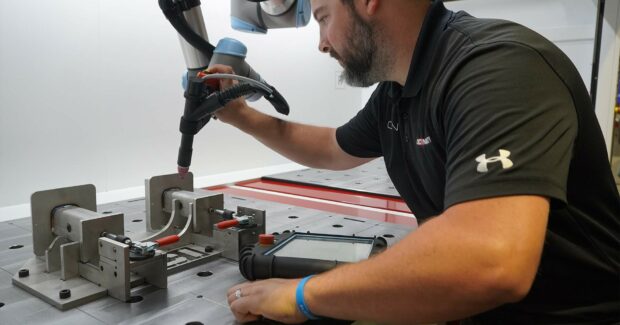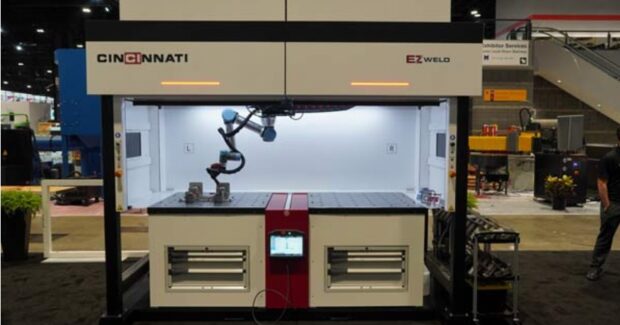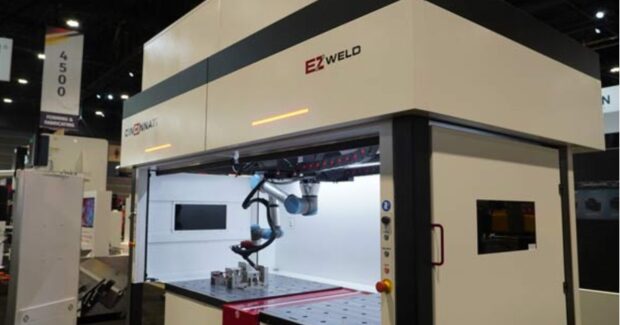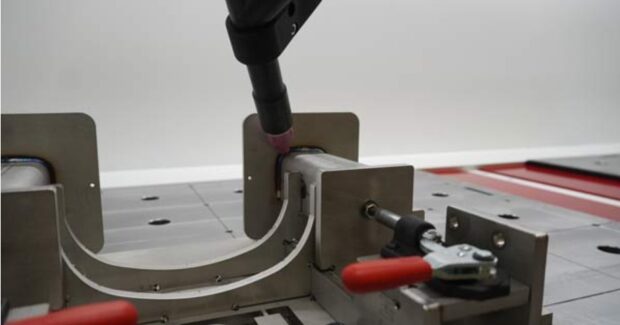Auto TIG: Automating TIG Welding is Becoming More Feasible
Automated TIG welding is something you don’t hear much about in the industry – especially in comparison to automated MIG welding – but interest is growing.
Posted: February 12, 2024

For many fabrication shops that perform TIG welding, the switch from manual to automation is a promising option. For those shops, it’s helpful to understand the pros and cons involved, with the pros definitely outweighing the cons.
One of the biggest requirements for manual TIG welding is the need for an experienced welder. TIG welding is in itself a very clean process, but it requires high consistency. This is one of the biggest benefits of switching to robotic TIG welding. The upfront cost of adding a collaborative robot is significantly less than an industrial robot and also provides quick ROI as it can help increase the welding productivity in a shop. This is the case with Cincinnati Inc.’s EZ Weld (formerly Cobotic 100T) welding cell, which the company notes is the first of its kind for TIG welding.
TIG welding is complex because the welds typically need to be very precise and clean. The quality of the final product can be important for industries where aesthetics are key. “This requires precision focus from a skilled welder, and everyone knows companies are struggling to find skilled laborers,” says Michael Fischesser, CI’s product application manager for EZ Weld.
The accurate feeding of the electrode wire is another concern. Pushing the wire and getting it to flow correctly at the correct speeds can be difficult. “But robotic TIG welding can repeat the weld,” Fischesser says. “Once the program is right, it will repeat that weld all day long. The robot is not going to become fatigued or create any waste. Arc-on time increases, which improves overall productivity. Also, wire usage stays consistent so you can project consumables usage easier because you know exactly what the robot is going to do on a daily basis.”
Cell operation

Fischesser further explains how the new TIG welding cell can help a shop. “Our EZ Weld welding cell is unique because we’re selling a full machine,” he says. “A lot of the robotic welders out there, both TIG and MIG, are just a table with a robot mounted on it so you still have to build a cell with safeguards. Our cell is fully enclosed. The doors come down when the welding starts and the operator can be working on both sides of it.”
The robotic TIG welding cell is simple to use and easy to program. Everything is done from the Universal Robots (UR) teach pendant so there is no offline programming. “The UR cobot can be programmed and taught easily in a matter of minutes so you can do a variety of parts or one-off parts,” he adds. “You can go from welding mild steel to aluminum very quickly. It provides an endless work cycle.”
The power supply itself is a Böhler Welding 320-amp power source. The cell is 12 ft. by 10 ft. with each table being 4 ft. by 4 ft. and suitable for large or small production batches. Overall, the lightweight, compact cell can be easily repositioned using a forklift or crane.
Better than a welder
The UR5e cobot has six axes and six rotating degree-of-freedom joints to ensure maximum robot arm usage. A seventh axis allows better reach, so the shop can weld something about 10 ft. long or split the two cells and the seventh axis allows movement from left to right. “You get the reach of the robot, which is about 33.5 in. with the UR5e cobot, but you also now have the seventh axis that runs the whole length of the machine so you can reach the whole cell,” Fischesser says. “Because the seventh axis is mounted up in the air, it keeps it from getting bound up anywhere and it can really hold true, especially with radiuses. The robot can easily do radiuses just off teach points so with the axes you can move it into the exact location you need to keep running the same consistent weld.”
And these are all things that might be a limitation for a human welder or fatigue them more quickly. Working in tight areas all day can become a fatigue point, which can become a safety issue. The robot can perform in these tight spaces much easier.
Another feature of the welding cell is that it autonomously detects sheet metal deformation without operator intervention. “If you have any deformations in the material, the system automatically senses it by reading the voltage coming off the torch and programming it back to the control,” Fischesser notes. “This is a big help because if you have an abnormality in the material, that spot might turn into a bad weld. And with TIG welding, you’re trying to make that nice bead across the whole material. That is hard for a welder without a lot of experience to do.
“What’s nice about our sheet metal deformation detection,” he adds, “is that you can set it with a tolerance – you can hold it to where it’s not allowed to get out of tolerance at all or you can give it a little bit of leeway.”
Safe approach

So what was the approach to safety in developing the robotic TIG welding cell? The UR cobot itself offers many safety features. “The UR cobot comes preset with the safety features, but you can tighten them up even further,” Fischesser says. “You can set up planes so the robot will stop because it knows it’s not supposed to go there.”
“The doors really help with safety as well because when the doors come down, they will not come up until they know the welder is off,” he continues. “We have weld glass on the side of the cell so you can check it to make sure everything is okay. It also has three emergency stops. Dual work zones allow welding in one zone while operators safely unload parts in the other. Also, if the control senses the welding gas is not correct, it stops the robot and the welder. It’s all integrated together.”
The decision to develop robotic TIG welding equipment by CI is part of the company’s focus on helping customers succeed in their businesses. “We’ve always been in the fab business and almost every one of our customers has welding in their shop,” Fischesser says. “There isn’t a ton of robotic TIG welding in the marketplace so we wanted to help our customers automate the process. In general, customers have seen 45 to 65 percent productivity increases just due to having the robotic TIG welding cell in place and having their human welders work side by side with it.
“Customers say the cell is easy to deploy and learn, highly repeatable and efficient, which all provides a faster ROI,” he concludes. “It simplifies production by automating what is a laborious job.”
About Cincinnati Incorporated
Cincinnati Incorporated (CI) is a U.S.-based, build-to-order machine tool manufacturer with over 125 years in the industry. Our engineering and manufacturing expertise makes us the ideal partner for companies building innovative products that demand extraordinary durability, stability, and industry-leading features. At our state-of-the-art, Ohio-based facility, we develop and build custom software, dependable laser cutting systems and automation equipment as well as metal fabrication equipment, including press brakes, shears, and PM presses. Our extensive knowledge puts us in a unique position to help drive efficiency in your manufacturing process no matter how simple or complex.














